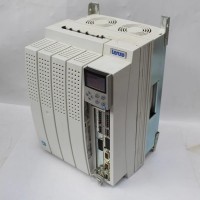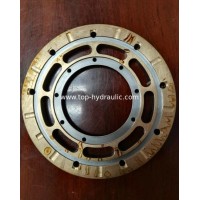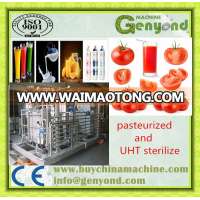-
Phone
86-25-86136265
-
Address
P 345, No. 12, Mozhou East Road, Moling Street, Jiangning, Nanjing, Jiangsu, China
-
E-mail
LatestProducts
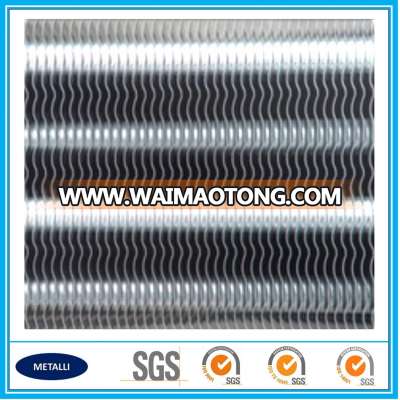
Heat Exchanger Fin
China Heat Exchanger Fin, Find details about China Heat Exchanger Fin, Aluminum Fin from Heat Exchanger Fin - Nanjing Metalli Industrial Co., Ltd.
Description
Basic Info
- Model NO.: af1004
- Principle: Mixing Heat Exchanger
- Material: Aluminum, Aluminum Alloy
- Width: up to 600 mm or Custom
- Fpi: 4, 5, 6, ...15, etc.
- Fin Type: Plate Fin
- Surface Finish: Original or Custom
- Structure Material: Metal Material
- Heat Transfer Surface: Plate Heat Exchanger
- Ceramic Heating Equipment Type: Na
- Recuperative Heat Exchanger Type: Na
- Application: Heater, Cooler, Vaporizer, Condenser, Heater
- Style: Plate
- Length: up to 1200 mm or Custom
- Wall Thickness: 0.12, 0.15, 0.2, etc.
- Material Temper: H14, H18, O, H24, etc.
- Fin Form: Plain, Serrated, Louvered, Perforated, Wavy
- Packing Way: Plywood Case
- Core: Aluminum Heat Exchanger
- Type: Aluminum Heat Exchange
- Mixing Heat Exchanger Type: Na
- Origin: Jiangsu, China
Product Description
| 1. Aluminum alloy number | ||||||||||||||
| No. | Aluminum Alloy Number | Temper | ||||||||||||
| 1.1 | Typical AA3003, cladding materials AA4343/3003/4343,4045/300/4045,4004/3003/4004 ,4104/3003/4104,4343/3003/7072,etc. |
H14/H18/O/H24,etc. | ||||||||||||
| 2. Product size and tolerance | ||||||||||||||
| No. | Specification | Size | Tolerance | |||||||||||
| 2.1 | Length (mm) | 500,600,1200,3000 or longer | ±2 | |||||||||||
| 2.2 | Width (mm) | 45,63,94,113,140 or custom | ±0.1 | |||||||||||
| 2.3 | Height (mm) | 3,4.7,9.5 or custom | ±0.03 | |||||||||||
| 2.4 | Wall Thickness (mm) | 0.1,0.15,0.2,0.5,0.6,0.8 or custom | ±0.01 | |||||||||||
| 2.5 | FPI (fin quantity per inch) | 4,5,6,7,8,9,10,12,15,etc. | ±1 | |||||||||||
| 3. Chemical composition for some typical alloys | ||||||||||||||
| No. | AA number | Chemical Composition (%) | ||||||||||||
| Si | Fe | Cu | Mn | Mg | Zn | Ti | Zr | Bi | Others | Al | ||||
| Each | Total | |||||||||||||
| 3.1 | 3003 | 0.6 | 0.7 | 0.05-0.2 | 1-1.5 | 0.05 | 0.1 | 0.05 | 0.15 | RE | ||||
| 3.2 | 3005 | 0.6 | 0.7 | 0.3 | 1.0-1.5 | 0.2-0.6 | 0.25 | Cr 0.1 | 0.05 | 0.15 | RE | |||
| 3.3 | 4045 | 9.0-11.0 | 0.8 | 0.3 | 0.05 | 0.05 | 0.1 | 0.05 | 0.15 | RE | ||||
| 3.4 | 4047 | 11.0-13.0 | 0.8 | 0.3 | 0.15 | 0.05 | 0.2 | 0.05 | 0.15 | RE | ||||
| 3.5 | 4104 | 9.0-10.5 | 0.8 | 0.25 | 0.1 | 1.0-2.0 | 0.2 | 0.05-0.2 | 0.05 | 0.15 | RE | |||
| 3.6 | 4343 | 6.8-8.2 | 0.8 | 0.25 | 0.1 | 0.05 | 0.2 | 0.05 | 0.15 | RE | ||||
| 3.7 | 6060 | 0.3-0.6 | 0.1-0.3 | 0.1 | 0.1 | 0.35-0.6 | 0.15 | 0.1 | Cr 0.05 | 0.05 | 0.15 | RE | ||
| 3.8 | 6061 | 0.4-0.8 | 0.7 | 0.15-0.4 | 0.15 | 0.8-1.2 | 0.25 | 0.15 | Cr 0.04-0.35 | 0.05 | 0.5 | RE | ||
| 3.9 | 6063 | 0.2-0.6 | 0.35 | 0.1 | 0.1 | 0.45-0.9 | 0.1 | 0.1 | Cr 0.1 | 0.05 | 0.15 | RE | ||
| 4. Mechanical properties for some typical alloys | ||||||||||||||
| No. | Alloy number | Thick. (mm) |
Temper | Yield Strength Rp0.2(Mpa). Min |
Tensile Strength Rm (Mpa) |
Elongation (%) A50,Min |
Typical usage | |||||||
| 4.1 | 3003 | 0.08-0.15 | O | 35 | 95-135 | 8 | Fins | |||||||
| 4.2 | 3003 | 0.16-0.35 | O | 35 | 95-135 | 10 | Fins | |||||||
| 4.3 | 3003 | 0.15-0.3 | H12 | 90 | 120-175 | 0.5 | Fins | |||||||
| 4.4 | 3003 | 0.06-0.08 | H14 | 125 | 145-185 | 0.5 | Fins | |||||||
| 4.5 | 3003 | 0.081-0.3 | H14 | 125 | 145-200 | 0.5 | Fins | |||||||
| 4.6 | 3003 | 0.06-0.16 | H16 | 160 | 165-205 | 0.5 | Fins | |||||||
| 4.7 | 3003 | 0.2-0.3 | H24 | 125 | 145-205 | 6 | Fins | |||||||
| 4.8 | 3003-1 | 0.35-3.0 | O | 35 | 95-135 | 20 | Plate | |||||||
| 4.9 | 3003-1 | 0.40-3.0 | H14 | 125 | 145-185 | 3 | Plate | |||||||
| 4.10 | 3003-1 | 1.0-3.0 | H24 | 125 | 145-185 | 10 | Plate | |||||||
| 4.11 | 3003 | 0.25-0.35 | H24 | 130 | 155-205 | 6 | Fins for air cooler | |||||||
| 4.12 | 3003 | 0.1-0.2 | H14 | 125 | 145-185 | 1 | Fins | |||||||
| 4.13 | 3003 | 0.1-0.3 | O | 35 | 95-135 | 10 | Fins | |||||||
| 4.14 | 3003 | 0.3-0.8 | H14 | 125 | 145-185 | 2 | Plate | |||||||
| 4.15 | 3003 | 0.8-2.5 | H14 | 125 | 145-185 | 4 | Plate | |||||||
| 4.16 | 3003 | 0.5-1.6 | O | 35 | 145-185 | 20 | Plate | |||||||
| 4.17 | 3003-1 | 0.3-1.8 | O | 35 | 95-135 | 20 | Band | |||||||
| 4.18 | 3003-1 | 0.5-4.0 | O | 35 | 95-135 | 25 | Plate | |||||||
| 4.19 | 3005 Mod | 0.25-0.6 | H24 | 150 | 185-235 | 8 | Long life tube | |||||||
| 4.20 | 4343 | 0.07-3.0 | O | 35 | 95-150 | 8 | Sheet for brazing | |||||||
| 4.21 | 4343 | 0.07-3.0 | H14 | 120 | 140-200 | 0.5 | Sheet for brazing | |||||||
| 4.22 | 4045 | 0.07-3.0 | O | 35 | 95-150 | 8 | Sheet for brazing | |||||||
| 4.23 | 4045 | 0.07-3.0 | H14 | 120 | 140-200 | 0.5 | Sheet for brazing | |||||||
| 4.24 | 4104 | 0.07-3.0 | O | 35 | 95-150 | 8 | Sheet for brazing | |||||||
| 4.25 | 4104 | 0.07-3.0 | H14 | 120 | 140-200 | 0.5 | Sheet for brazing | |||||||
| 4.26 | 4047 | 0.07-3.0 | O | 35 | 95-150 | 8 | Sheet for brazing | |||||||
| 4.27 | 4047 | 0.07-3.0 | H14 | 120 | 140-200 | 0.5 | Sheet for brazing | |||||||
| 4.28 | 3005 | 0.8-4.5 | O | 40 | 80-120 | 20 | Vacuum plate | |||||||
| 4.29 | 3005 | 0.6-4.5 | H22 | 110 | 145-195 | 15 | Vacuum plate | |||||||
| 4.20 | 6060 | 0.8-4.5 | O | ≤85 | ≤150 | 20 | Vacuum plate | |||||||
| 4.21 | 6063 | 0.8-4.5 | O | ≤85 | ≤150 | 20 | Vacuum plate | |||||||
| 5. Surface finish and other properties | ||||||||||||||
| No. | Item | Description | ||||||||||||
| 5.1 | Surface finish | a. The material shall bright finish; b. The material shall be from pinholes and tearing | ||||||||||||
| 5.2 | Fin type | Plain type,Louvered type,perforated type,serrated type and wavy type,etc. | ||||||||||||
| 6. Packing,Shipping and others | ||||||||||||||
| No. | Item | Description | ||||||||||||
| 6.1 | Packing | To be packed in wooden crate with polythene cover for water protection | ||||||||||||
| 6.2 | Marking | Each box to be legibly marked with the name of the manufacturer or supplier, the alloy designation of material,condition,dimensions and weight | ||||||||||||
| 6.3 | Shipping tools | Ship goods by van to departune port then by sea to desitination port | ||||||||||||
| 6.4 | Quantity variation | ±10% variation with order quantity shall be acceptable | ||||||||||||
| 7.Quality management and spot management | ||||||||||||||
| No. | Item | Description | ||||||||||||
| 7.1 | Quality control | 1. Quality assurance a. Incoming material quality assurance; b. Process quality assurance; c. First sample quality assurance; d. Final quality assurance. 2. Process management-The right results are from the right process a. Production process card control; b. Standard operational procedure;c.Job certification;d. Quality chart monitor. 3. Equipment and facility management a. Periodic maintenance; b.Preventative maintenance. 4. Mold management a. Mold life management; b.Periodic and preventative maintenance; c. Periodic inspection. |
||||||||||||
| 7.2 | Inspection Tools | Altimeter,Vernier caliper,Micrometer,3D coordinate measuring instrument | ||||||||||||
| 7.3 | Spot management | "5S" management (sort,set in order,shine,standard,sustainable). | ||||||||||||

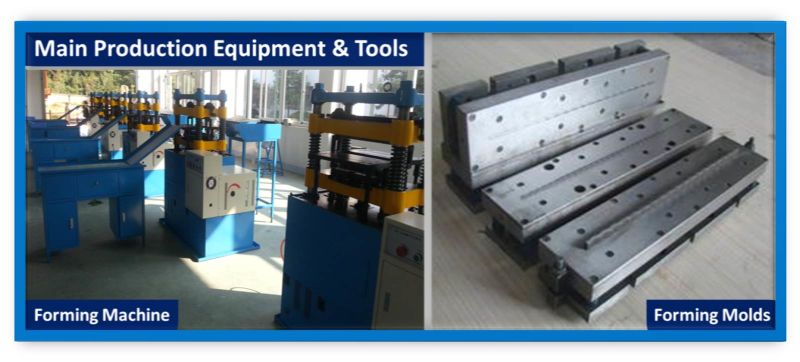
8. Introduction to fins
In the study of heat transfer, fins are surfaces that extend from an object to increase the rate of heat transfer to or from the environment by increasing convection. The amount of conduction, convection, or radiation of an object determines the amount of heat it transfers. Increasing the temperature gradient between the object and the environment, increasing the convection heat transfer coefficient, or increasing the surface area of the object increases the heat transfer. Sometimes it is not feasible or economical to change the first two options. Thus, adding a fin to an object, increases the surface area and can sometimes be an economical solution to heat transfer problems.
Because fins are used to improve heat transfer, it is important to allow open spaces toward optimization. In other words, the shape of fins must be optimized such that the heat transfer density is maximized when the space and the materials used for the finned surfaces are constraints
Fins are most commonly used in heat exchanging devices such as radiators in cars, computer CPU heatsinks, and heat exchangers in power plants. They are also used in newer technology such as hydrogen fuel cells. Nature has also taken advantage of the phenomena of fins. The ears of jackrabbits and fennec foxes act as fins to release heat from the blood that flows through them.
